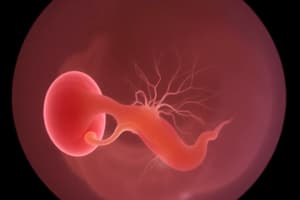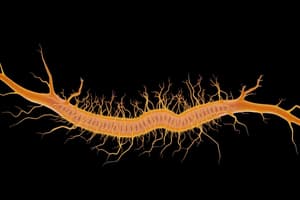Podcast
Questions and Answers
What is the condition called if closure fails caudally from the cervical region?
What is the condition called if closure fails caudally from the cervical region?
- Spinal fusion
- Spina bifida (correct)
- Scoliosis
- Meningocele
Which component of the mesodermal germ layer is responsible for forming the urogenital structures?
Which component of the mesodermal germ layer is responsible for forming the urogenital structures?
- Lateral plate mesoderm
- Paraxial mesoderm
- Intermediate mesoderm (correct)
- Chordamesoderm
What tissues do somites give rise to?
What tissues do somites give rise to?
- Muscle and nerve tissues only
- Epithelial and connective tissues
- Myotome, sclerotome, and dermatome (correct)
- Neurons and glial cells
Which structure does the endodermal germ layer NOT contribute to?
Which structure does the endodermal germ layer NOT contribute to?
What happens to the embryonic disc during embryonic folding?
What happens to the embryonic disc during embryonic folding?
What is the primary period during which major features of body shape are established?
What is the primary period during which major features of body shape are established?
Which germ layer is responsible for forming the central nervous system?
Which germ layer is responsible for forming the central nervous system?
What is the first step in the process of neurulation?
What is the first step in the process of neurulation?
What can occur if neural tube closure does not happen in the cranial region?
What can occur if neural tube closure does not happen in the cranial region?
Which organ is NOT derived from the ectodermal germ layer?
Which organ is NOT derived from the ectodermal germ layer?
What structure is formed by the fusion of the neural folds during neurulation?
What structure is formed by the fusion of the neural folds during neurulation?
What happens at the anterior and posterior neuropores during neurulation?
What happens at the anterior and posterior neuropores during neurulation?
What does the endoderm germ layer primarily give rise to?
What does the endoderm germ layer primarily give rise to?
What happens to the flat embryonic disc as organ systems develop?
What happens to the flat embryonic disc as organ systems develop?
What structure connects the embryo to the placenta during development?
What structure connects the embryo to the placenta during development?
Which mesodermal layer gives rise to somites?
Which mesodermal layer gives rise to somites?
What does the endodermal germ layer primarily provide?
What does the endodermal germ layer primarily provide?
Which of the following structures is NOT derived from the mesodermal germ layer?
Which of the following structures is NOT derived from the mesodermal germ layer?
During which weeks does the embryonic period occur?
During which weeks does the embryonic period occur?
What process describes the formation of the neural tube from the neural plate?
What process describes the formation of the neural tube from the neural plate?
Which of the following structures does NOT originate from the ectodermal germ layer?
Which of the following structures does NOT originate from the ectodermal germ layer?
What forms at the cephalic and caudal ends of the neural tube prior to fusion?
What forms at the cephalic and caudal ends of the neural tube prior to fusion?
What occurs when the neural tube fails to close in the cranial region?
What occurs when the neural tube fails to close in the cranial region?
Which germ layer is responsible for forming the peripheral nervous system?
Which germ layer is responsible for forming the peripheral nervous system?
What is the significance of the neural grooves formed during neurulation?
What is the significance of the neural grooves formed during neurulation?
Which major feature is established as a result of organ formation during the embryonic period?
Which major feature is established as a result of organ formation during the embryonic period?
Flashcards are hidden until you start studying
Study Notes
Embryonic Period
- The embryonic period occurs during weeks 3-8 of gestation.
- During this period, the three germ layers, ectoderm, mesoderm, and endoderm, form tissues and organ systems.
Ectodermal Germ Layer
- The ectoderm gives rise to structures that interact with the external environment.
- These include:
- Central nervous system (CNS)
- Peripheral nervous system (PNS)
- Sensory epithelium of the ear, nose, and eye
- Skin, hair, and nails
- Pituitary, mammary, and sweat glands
- Enamel of the teeth
Neurulation
- Neurulation is the process of forming the neural tube from the neural plate.
- The neural folds elevate, forming the neural groove, and fuse to create the neural tube.
- The anterior and posterior neuropores initially connect the neural tube to the amniotic cavity.
- Complete closure of the neuropores marks the end of neurulation, resulting in a closed tubular structure representing the CNS.
Neural Tube Defects (NTDs)
- NTDs occur when the neural tube fails to close completely.
- Anencephaly results from failure to close in the cranial region, leading to incomplete brain development.
- Spina bifida occurs when the neural tube fails to close from the cervical region caudally.
Mesodermal Germ Layer
- The mesodermal germ layer forms essential components of the body.
- Paraxial mesoderm develops into somites, which give rise to myotome (muscle), sclerotome (cartilage and bone), and dermatome (dermis).
- Intermediate mesoderm differentiates into urogenital structures.
- Lateral plate mesoderm splits into parietal (somatic) and visceral (splanchnic) layers.
Endodermal Germ Layer
- The endodermal germ layer forms the epithelial lining of:
- Gastrointestinal tract (including liver and pancreas)
- Respiratory tract (including thyroid and parathyroids)
- Urinary bladder
- It also forms the lining of the tympanic cavity and auditory tube.
Embryonic Folding
- Embryonic folding occurs due to organ system development and rapid CNS growth.
- This transforms the flat embryonic disc into a curved shape, pulling the amnion ventrally.
- The embryo lies within the amniotic cavity, with connections to the yolk sac and placenta through the vitelline duct and umbilical cord, respectively.
Embryonic Period
- The embryonic period is from the third to the eighth weeks of gestation.
- During this period, the three germ layers (ectoderm, mesoderm, and endoderm) differentiate into distinct tissues and organ systems.
Derivatives of the Ectodermal Germ Layer
- The outer layer, ectoderm, gives rise to structures interacting with the outside world.
- These structures include the central nervous system (CNS), peripheral nervous system (PNS), sensory epithelium of the ear, nose, and eye, skin, hair, nails, pituitary, mammary, and sweat glands, and tooth enamel.
Neurulation
- Neurulation is the process transforming the neural plate into the neural tube.
- The neural plate lengthens, with its edges elevating to form neural folds.
- The midline depression forms the neural groove.
- The neural folds fuse in the midline, forming the neural tube.
Neural Tube Defects (NTDs)
- Neural tube defects occur when the neural tube fails to close completely.
- Anencephaly results from the failure of the neural tube to close in the cranial region.
- Spina bifida occurs when closure fails from the cervical region caudally.
Derivatives of the Mesodermal Germ Layer
- The middle layer, mesoderm, forms various structures.
- Paraxial mesoderm differentiates into somites, which give rise to muscle tissue, cartilage and bone, and the dermis of the skin.
- Intermediate mesoderm develops into urogenital structures.
- Lateral plate mesoderm splits into parietal and visceral layers.
Derivatives of the Endodermal Germ Layer
- The inner layer, endoderm, forms the epithelial lining of the gastrointestinal tract, respiratory tract, and urinary bladder.
- It also forms the lining of the tympanic cavity and auditory tube.
Embryonic Folding
- The embryonic disc curves into the fetal position due to organ formation and growth of the central nervous system.
- The amnion is pulled ventrally, and the embryo is enveloped in the amniotic cavity.
- The connection to the yolk sac and placenta is maintained through the vitelline duct and umbilical cord, respectively.
Studying That Suits You
Use AI to generate personalized quizzes and flashcards to suit your learning preferences.




